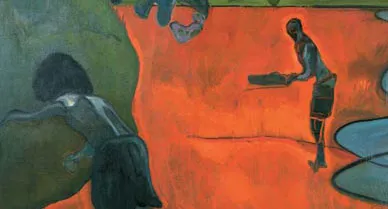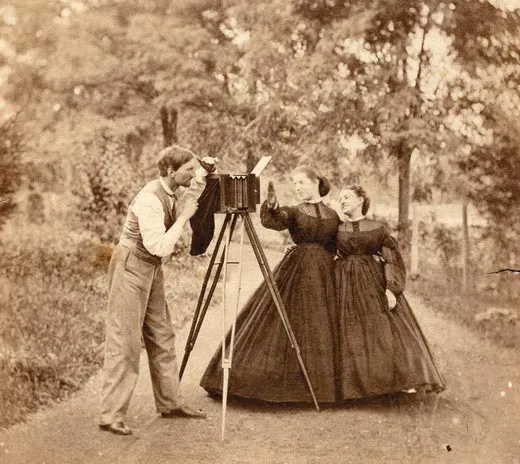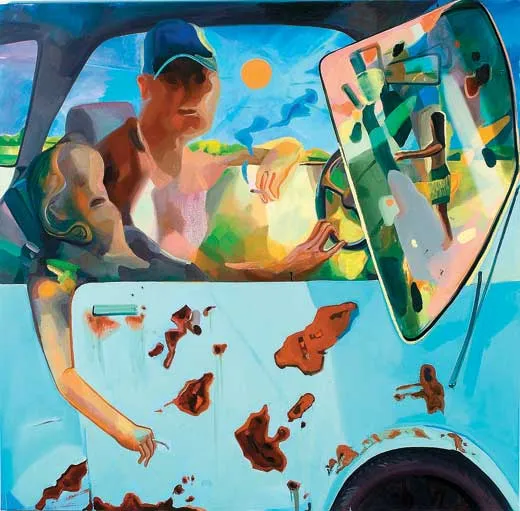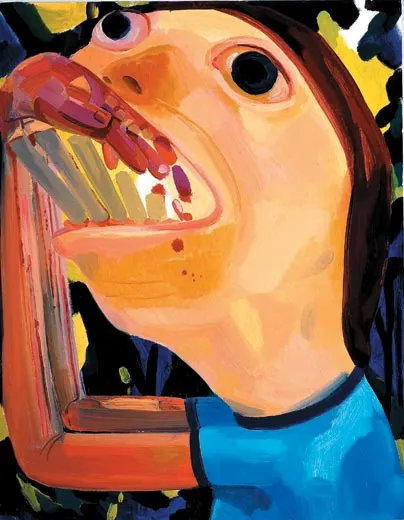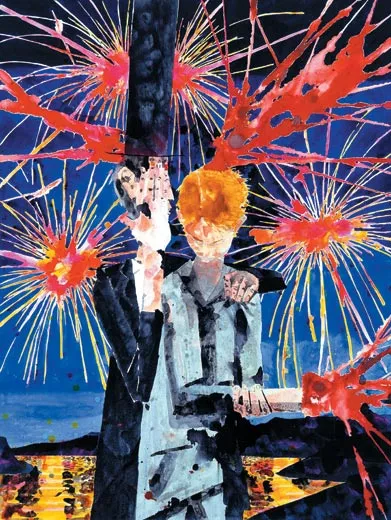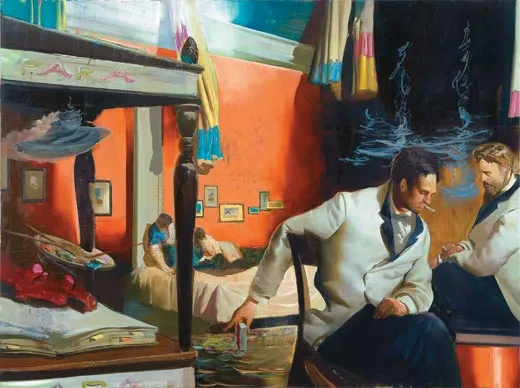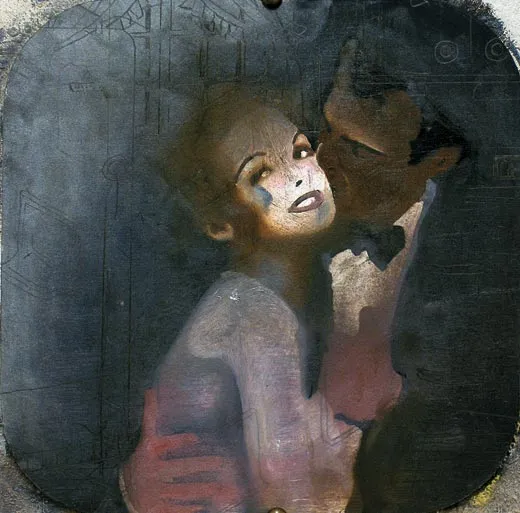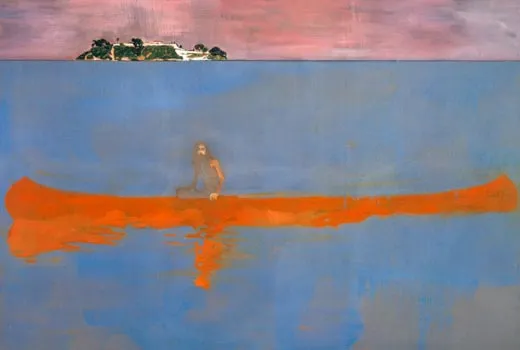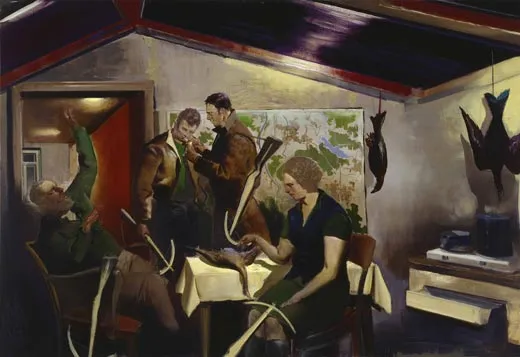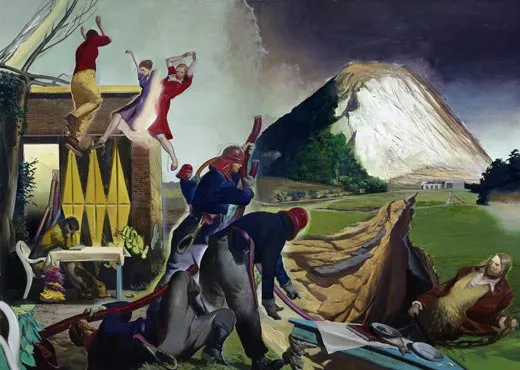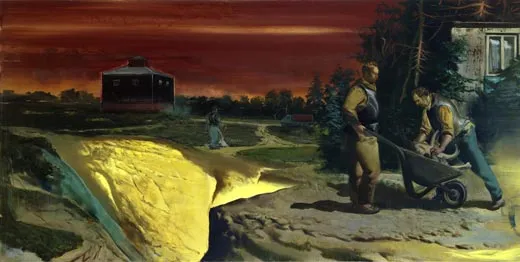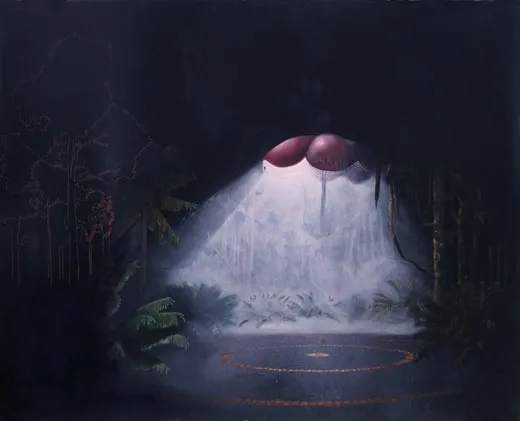Back to the Figure
Recognizable forms are showing up in the works of a new wave of contemporary painters
The death of painting was first predicted in the middle of the 19th century, when the advent of photography seemed to snatch reality out of the painter's hand. "If photography is allowed to stand in for art in some of its functions," wrote French poet and art critic Charles Baudelaire in 1859, "it will soon supplant or corrupt it completely." Artists have been trying to come to terms with photography's implications ever since.
Impressionists such as Monet and Renoir, rejecting the static, mechanical imagery of photographs as well as the stale academic painting of their time, set out to paint their own impressions of how the eye perceives light and atmosphere in nature. Some of their contemporaries, including Degas and Toulouse-Lautrec, took a different tack. They began using photographs for inspiration—cropping their images as the camera might, for example, and introducing distortions of perspective based on the camera's lens.
Then, one hundred years ago, Matisse and Picasso made the radical paintings that would define a new era of modern art. Matisse disfigured the figure with his bulging Blue Nude in 1907, painting from a photograph to free his imagination and break habits formed by drawing from life. Picasso also used photographs to paint his 1907 Les Demoiselles d'Avignon, with each figure seeming like a multiple exposure, seen from different angles at the same time—a decisive step into Cubism.
As the 20th century progressed, painters such as Wassily Kandinsky and Jackson Pollock abandoned the concept of art as representation altogether, producing canvases that contained no recognizable objects at all. In their "abstract" works, the paint itself became the subject. By the 1960s, conceptual artists—inspired by Marcel Duchamp and other Dadaists of the 1920s—adopted the view that art should aim at the mind, not the eye, turning out paintings in which the idea behind the work was more important than the work itself. With a few obvious exceptions—Pop Art, Photo Realism and artists such as David Hockney—representational or figurative art was largely considered a thing of the past by the end of the 20th century. But in recent years, a number of contemporary painters have begun reaching back to the roots of modern art to find new modes of expression. They are mixing the human figure and other recognizable forms with elements of abstraction and ambiguous narrative in ways not seen before.
"The excitement around my profession right now is tremendous," says Joachim Pissarro, a curator of painting and drawing at New York's Museum of Modern Art. "Thirty years ago, there was all this talk of the end of painting. Today nobody cares about that." For the young generation, he says, "the polarization between abstraction and representation that existed in the last half of the 20th century is just meaningless. What we're seeing now is very interesting. And totally new."
Scattered from Brooklyn to Trinidad to Leipzig, Germany, the artists represented in these pages are renewing "a belief in painting," says Laura Hoptman, senior curator at New York City's New Museum of Contemporary Art.
Peter Doig
"When people started to become interested in my work in the late 1980s, painting was completely off the agenda," says Peter Doig, a 49-year-old Scot living in Trinidad. "What the galleries considered cutting edge was all conceptual—painting about painting, art that said something about the way it is made. I deliberately worked against that. For me, once you're a painter, you're constantly compelled to look at the world as a potential subject for painting. And that goes from seeing something on the street, to seeing something in a movie, in a magazine, everything really."
Doig's studio, in a renovated rum distillery in Trinidad's capital city, Port of Spain, is full of large canvases depicting junglelike landscapes, paint-smeared rivers and ambiguous figures. When he left London to move to Trinidad in 2003, many of his friends called it "doing a Gauguin," after the French artist Paul Gauguin, who moved to Tahiti in 1891 to become one with nature. Doig's style is sometimes compared to Gauguin's, but his approach to painting is quite different. His method hinges on a kind of information processing that often starts with a photograph, he says, because painting from photographs distances him from what is real or true. "Why does a painting have to be truthful?" he asks.
Doig has made several paintings from an old postcard he bought in a London junk shop that depicts a river scene in India. "When I paint directly from nature," he says, "I get too caught up in trying to get it right. Using photography, or a postcard, allows me just to take what I want and leave the rest out. I made a photograph of the tiny guru in the postcard, and took another photo of that, and I blew it up so it became a blurry blob, and I painted from that, and he became a sort of bearded man, something mysterious and black. I don't know if he's a religious figure, or a fanatic, but there's something kind of spiritual about him."
He points to a 9-by-12-foot canvas of a sketchy figure climbing a palm tree, hugging the trunk and peering out from an abstract void of brushstrokes, drips and cracks. "Those drips and cracks are the kinds of beautiful things in painting that are unique," he says. "You take chances and they're given to you, but I'd hate them to become a mannerism or gimmick." It was the figure, however, that most struck SITE Santa Fe director Laura Heon when the painting was shown at the museum's 2006 Biennial. "In a sense, it's a return to humanism," she says. "There's something very generous about making a picture of a human being."
A major retrospective of Doig's work will open at the Tate Modern in London in February.
Dana Schutz
In Dana Schutz's paintings, the fake and the real are hard to tell apart. "I know my images are constructed, but I believe in them when I'm painting," she says in her studio in an old industrial building turned artists' co-op in Brooklyn. Schutz, 30, likes to create figures and put them into different scenarios in a series of paintings, where they seem to take on a life of their own. One such series is of figures she calls "self-eaters"—a stripped-down form of people who survive by feeding on parts of their own bodies and then reconstructing themselves. The paintings, with their fantastic imagery and what she calls her "extroverted colors"—hot pinks and reds, electric purples and jungle greens—have been praised as a new Expressionism, and it is easy to interpret them in terms of social ills—from anorexic models to ravenous consumerism—or even as glimpses into the artist's psyche. But Schutz disagrees.
"I'm not an Expressionist," she protests. "These paintings are not about me expressing how I feel at all." The self-eaters, she says, "are a pictorial solution; you can take them apart and put them together again. It's like they just became material."
But Schutz does say that her paintings are sometimes inspired by what she sees on the Internet or is thinking about at the time. "I want these paintings to start somewhere in the public imagination, where people feel like they could know that story, like plastic surgery or production-consumption, or the ways we make alternative histories for ourselves," she says. "More and more I feel like the most radical thing art can do is give someone an experience they feel is unfamiliar in some way."
For Schutz, there's no hard line between abstract and figurative painting. "I don't think of them as being something separate." In one new painting of a man and woman driving, the figures in the car seem almost plastic, as if they're melting in a hot Hawaiian landscape. "The way I'm thinking about them," she says, "is that in the future, if you were looking back at us, what features would remain, in a slightly distorted or generalized way?
"Maybe we're refiguring the figure," she continues. "Making paintings about painting just sounds crazy. All that talk about the paint. I think artists now want to be making meaning and having an effect. It's very different from the 20th century."
An exhibition of Schutz's work opens in November at the Contemporary Fine Arts Gallery in Berlin, Germany.
Neo Rauch
In Leipzig, 47-year-old German artist Neo Rauch is influencing a generation of post-cold-war painters with ambiguous paintings that mix realism with fantasy, the ordinary with the bizarre. Drawing on the graphic styles of Eastern Bloc comics and commercial art, the Social Realism of communist East Germany, his own dream imagery and elements of his urban landscape, Rauch paints the kind of figures you might find in propaganda posters, but he sets them in scenes that, he says, are "confusingly plausible"—at once familiar and strange.
Rauch describes his paintings as allegories with a personal iconography that remains private. He recently told an interviewer for New York's Metropolitan Museum of Art that his decisions as a painter may defy reason—even his own. But what he includes in a painting has its own reality, he says, because "despite all the desire for interpretation, painting should retain the privilege of placing what cannot be verbalized into an obvious structure." Rauch describes his process of making a painting as a struggle to balance what's recognizable with what's inexplicable. "For me, he has said, "painting means the continuation of a dream with other means."
An exhibition of Rauch's work is currently on view at the Metropolitan Museum of Art in New York City (through Oct. 14).
Barnaby Furnas
Barnaby Furnas, like fellow Columbia University art school graduate Dana Schutz, has set up his studio in a converted industrial loft in Brooklyn. His paintings, inspired by late-19th-century French history painting, combine figurative elements with techniques he's derived from graffiti and Abstract Expressionism.
"As a teenager growing up in inner-city Philadelphia, I was a graffiti writer first," he says. "I got into all sorts of trouble, got arrested, but I always had one foot in art class." Eventually, a friend's father took him to some art galleries in New York City. "That's really the only way I would have even known that the art world ever existed," he says.
Furnas, 34, paints his canvases flat on the floor, as Jackson Pollock did. But instead of dripping oil paint à la Pollock, he creates puddles of water-based paint that he piles one on top of the other to create form. For a series about the Civil War, he filled a syringe with red acrylic paint that he squirted over his canvases to represent blood. "Oils would never dry in time for the way I'm using paint," he says, "flat on the ground, in puddles. A lot of that goes back to graffiti. One of the things I liked about graffiti is that it deliberately misuses material. You could take spray-can caps off of one aerosol, say a countertop cleaner, for instance, and put it on a paint spray can and get a completely different effect from the nozzle....I've never bothered with easels or brushes even. I have a huge collection of spray-can caps, the way I imagine some oil painters have brushes. In my work, there's a sort of willful mixture of what's in the hardware store and what's in the art store."
In art school at Columbia, Furnas found himself rebelling against an older generation of teachers who were, he says, "conceptual and postmodern artists, almost no painters." He saw painting as an act of self-expression that was out of vogue. He also wanted his work to be accessible to viewers without the need for academics to interpret it. "I didn't want these people in black suits talking about my work," he says. "I didn't want an intermediary." He decided to "go back to the seeds of Modernism," he says, "to Courbet and Géricault and Manet, to late-19th-century French history painting. I was able to reinvestigate the genre and come at it in a different way. So I've become this sort of Modernist thrift-store shopper!"
An exhibition of Furnas' work is scheduled for spring at the Stuart Shave/Modern Art gallery in London.
Katherine Lee
In an old army barracks made into artists' studios at the College of Santa Fe, Katherine Lee, 22, wonders how her wired generation will look at art. "We read so many instant visual messages these days," she says, "like commercials—read it and get it—and I want a painting to be interesting longer than a commercial break. I think there is a fear of narrative, and it comes from the idea of ‘getting it.' People are so used to advertising that they want what they see in a painting to be pre-thought by someone else. But advertising does such a good job that maybe you have to find a new strategy."
A mysterious, almost black landscape with a patch of distant light is pinned to Lee's studio wall. It has the moody atmosphere and depth of a 19th-century landscape, but Lee painted it from several photographs using a mixture of graphite, oils and cans of spray paint. The dark foliage suggests a jungle or forest, and there's something that looks like a red umbrella in the midst of it all. But there are no people. It's hard to know anything about the scene, which is just what she wants. "That umbrella in the forest suggests something is going on," she says. "I like the idea that everything acts as potential content. I really don't think about what it means when I'm making it, because I know it's going to make its own meaning."
When she does paint human figures, as in an oil and graphite image of a romantic couple she calls Untitled Love, Lee wants the paint to interest a viewer as much as the image. "It's not exactly figurative painting," she says, "because it's not really about these people. When I started the painting, it really was just about the figure, but pretty soon that seemed too flat. I got really frustrated and sort of destroyed most of the painting, and then it was a lot better. I took a brush and just violently blurred everything. By abstracting everything to such an extent, the painting becomes open, it gains a lot of potential content as opposed to explicitly explaining itself."
Katherine Lee's paintings will be on view in a thesis show at the Fine Arts Gallery of the College of Santa Fe in May.
Elizabeth Neel
Elizabeth Neel, 32, a recent graduate of Columbia University's School of the Arts, is a painter whose work is adding to the new excitement about contemporary painting that blends abstraction and representation. In her Brooklyn studio, canvases are covered with large abstract brushstrokes reminiscent of de Kooning, yet they incorporate the kind of figures a painter such as Matisse might have imagined. Neel says her own sensibility is shaped by the flood of images around her, from advertising and television to films, videos and the Internet. "We are consumers of images almost from the day we're born," she says, and she thinks art now has to deal with that environment.
Granddaughter of 20th-century figurative painter Alice Neel, Elizabeth often surfs the Internet for images before starting a painting. She does not project photographs onto a canvas, but makes sketches of the images she wants to use. Sometimes, she says, the purely formal aspects of making a painting—the scale of her brushstrokes, for example—may change her interest in the picture and send her back to the Internet for new images and ideas. "I think painting can have a wonderful duality; it can be about itself and it can be about the world," she says, "and it's a good passage in a painting when that happens."
The British collector Charles Saatchi has purchased several of Neel's paintings and is including some of them in his on-going series of exhibitions, "The Triumph of Painting," at his London gallery. Neel will have a solo show at the Deitch Projects in New York City in the spring of 2008. Her work can be seen at the Deitch Projects Web site.
Writer and painter Paul Trachtman lives in New Mexico. His article about the Dadaists ran in the May 2006 Smithsonian.
